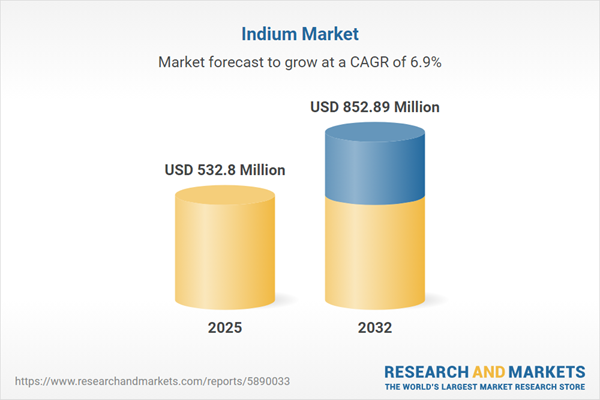Speak directly to the analyst to clarify any post sales queries you may have.
Indium, a critical metal with growing significance across electronics, renewable energy, and advanced manufacturing, is experiencing rising global demand as its role expands into new industrial domains. This in-depth analysis of the Indium Market provides decision-makers with targeted strategies, comprehensive segmentation, and up-to-date insights to navigate today’s evolving value chain.
Indium Market Snapshot
The Indium Market grew from USD 498.44 million in 2024 to USD 532.80 million in 2025. It is expected to continue growing at a CAGR of 6.94%, reaching USD 852.89 million by 2032. Market growth is propelled by evolving use cases in flat panel electronics, next-generation solar technologies, and advanced semiconductors. Senior leaders monitoring global supply chains recognize the market’s critical sensitivity to both raw material access and shifts in regulatory policies.
Scope & Segmentation of the Indium Market
- Applications: Chemicals (catalysts, coatings), Electronics (LCD screens, LED lighting, touchscreens, transparent conductive films), Photovoltaic (CIGS solar cells, heterojunction solar cells), Semiconductor (doping applications, optoelectronic devices), Solder Alloys (lead free solder, low temperature solder)
- Product Types: Compounds (indium arsenide, indium phosphide), Metal (ingot, powder, wire), Oxides (indium oxide, indium tin oxide)
- Purity Grades: High Purity, Standard Grade, Ultra High Purity
- Sourcing: Primary Mining, Secondary Recycling
- Regional Markets: Americas (United States, Canada, Mexico, Brazil, Argentina, Chile, Colombia, Peru), Europe, Middle East & Africa (including United Kingdom, Germany, France, Russia, Italy, Spain, Netherlands, Sweden, Poland, Switzerland, UAE, Saudi Arabia, Qatar, Turkey, Israel, South Africa, Nigeria, Egypt, Kenya), Asia-Pacific (China, India, Japan, Australia, South Korea, Indonesia, Thailand, Malaysia, Singapore, Taiwan)
- Key Companies Covered: Umicore SA, Indium Corporation, Dowa Metals & Mining Co., Ltd., Mitsui Mining & Smelting Co., Ltd., Korea Zinc Co., Ltd., Huachang Mineral & Metallurgical Co., Ltd., Zochem LLC, Yunnan Tin Company Group Ltd., American Elements Inc., Nyrstar NV
Key Takeaways
- Indium's exceptional properties, such as conductivity and ductility, sustain its use in technologies including display panels, solar cells, and advanced semiconductors.
- Market supply is influenced by its by-product sourcing from zinc and copper mining, making it vulnerable to geopolitical risks and price volatility.
- Innovative recycling and circular economy strategies are becoming essential to secure reliable indium access and address environmental legislation across jurisdictions.
- Manufacturers are integrating scenario planning and total-cost-of-ownership analyses to anticipate the impact of tariffs, regulatory changes, and transportation costs.
- The rise of alternative materials such as conductive polymers and graphene highlights ongoing innovation efforts, though indium remains integral to high-performance applications.
- Regional dynamics, including Asia-Pacific’s manufacturing leadership and EMEA’s regulatory focus, shape both consumption and sourcing strategies.
Tariff Impact
Recent United States tariffs on specific indium imports have prompted significant adjustments within global supply chains. Producers have altered export strategies, regional trade flows have shifted, and manufacturers have expedited recycling and new sourcing contracts to mitigate duty-related pressures. This evolving trade environment demands agile procurement strategies and ongoing policy monitoring.
Methodology & Data Sources
This report combines primary insights from industry interviews and expert roundtables with secondary research from trade databases, company disclosures, and peer-reviewed studies. Analytical frameworks include supply chain mapping and scenario planning, ensuring robust validation and actionable perspective throughout the analysis.
Why This Report Matters
- Identify market-critical supply risks and emerging growth opportunities aligned with advanced materials strategies.
- Benchmark procurement and sourcing decisions against comprehensive regional, product, and application segmentation.
- Support strategic planning with expert analysis on regulatory trends, secondary recycling, and the rise of alternative conductive materials.
Conclusion
The global Indium Market is evolving amid technological advances, regulatory shifts, and changing supply models. Senior decision-makers gain the insights needed to strategically address challenges and unlock new value in this dynamic sector.
Additional Product Information:
- Purchase of this report includes 1 year online access with quarterly updates.
- This report can be updated on request. Please contact our Customer Experience team using the Ask a Question widget on our website.
Table of Contents
3. Executive Summary
4. Market Overview
7. Cumulative Impact of Artificial Intelligence 2025
Companies Mentioned
The companies profiled in this Indium market report include:- Umicore SA
- Indium Corporation
- Dowa Metals & Mining Co., Ltd.
- Mitsui Mining & Smelting Co., Ltd.
- Korea Zinc Co., Ltd.
- Huachang Mineral & Metallurgical Co., Ltd.
- Zochem LLC
- Yunnan Tin Company Group Ltd.
- American Elements Inc.
- Nyrstar NV
Table Information
| Report Attribute | Details |
|---|---|
| No. of Pages | 181 |
| Published | October 2025 |
| Forecast Period | 2025 - 2032 |
| Estimated Market Value ( USD | $ 532.8 Million |
| Forecasted Market Value ( USD | $ 852.89 Million |
| Compound Annual Growth Rate | 6.9% |
| Regions Covered | Global |
| No. of Companies Mentioned | 11 |









